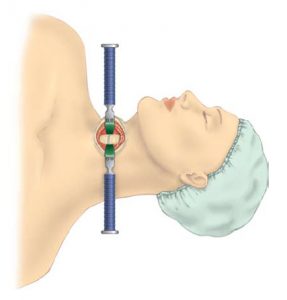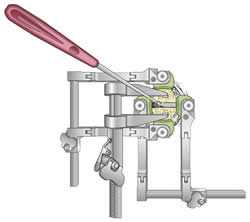What is it?
 Pain in the neck and extremities, among other symptoms, may occur when an intervertebral disc herniates – when the annulus fibrosus (tough, outer ring) of the disc tears and the nucleus pulposus (soft jelly-like center) squeezes out and places pressure on neural structures, such as nerve roots or the spinal cord. Bony outgrowths, called bone spurs or osteophytes, which form when the joints of the spine calcify, may also cause these symptoms.
Pain in the neck and extremities, among other symptoms, may occur when an intervertebral disc herniates – when the annulus fibrosus (tough, outer ring) of the disc tears and the nucleus pulposus (soft jelly-like center) squeezes out and places pressure on neural structures, such as nerve roots or the spinal cord. Bony outgrowths, called bone spurs or osteophytes, which form when the joints of the spine calcify, may also cause these symptoms.
Anterior cervical discectomy is an operation that involves relieving the pressure placed on nerve roots and/or the spinal cord by a herniated disc or bone spurs – a condition referred to as neural compression.
Through a small incision made near the front of the neck (i.e., the anterior cervical spine), the surgeon removes disc material and/or a portion of the bone around the nerve roots and/or spinal cord to relieve these compressed neural structures and to give them additional space.
Discectomy involves removing all or part of an intervertebral disc. The term discectomy is derived from the Latin words discus (flat, circular object or plate) and -ectomy (removal).
Why is it done?
 Pressure placed on neural structures, such as nerve roots or the spinal cord, by a herniated disc or bone spur may irritate these neural structures and cause: pain in the neck and/or arms; and lack of coordination, numbness or weakness in the arms, forearms or fingers. Pressure placed on the spinal cord as it passes through the neck (cervical spine) can be serious since most the nerves for rest of the body (e.g., arms, chest, abdomen, legs) have to pass through the neck from the brain.
Pressure placed on neural structures, such as nerve roots or the spinal cord, by a herniated disc or bone spur may irritate these neural structures and cause: pain in the neck and/or arms; and lack of coordination, numbness or weakness in the arms, forearms or fingers. Pressure placed on the spinal cord as it passes through the neck (cervical spine) can be serious since most the nerves for rest of the body (e.g., arms, chest, abdomen, legs) have to pass through the neck from the brain.
Patients who suffer from these symptoms are potential candidates for this operation.
The Operation
An understanding of what an anterior cervical discectomy involves will help you to approach your operation and recovery with confidence.
Incision
The operation is performed with you lying on your back. A small incision is made to one side of the front of your neck.
 Exposure
Exposure
After pulling aside the soft tissue – fat and muscle, your surgeon exposes the source of the neural compression.
Removal
Disc material – and, in some cases, a portion of the bone – around the nerve roots and/or spinal cord is then removed to relieve the compressed neural structures and to give them additional space.
Closure
The operation is completed when your surgeon closes and dresses the incision.
Recovery
Your surgeon will have a specific post-operative recovery/exercise plan to help you return to normal life as soon as possible. The amount of time that you have to stay in the hospital will depend on this treatment plan. You will normally be up and walking in the hospital by the end of the first day after the surgery.
As you read this, please keep in mind that all treatment and outcome results are specific to the individual patient. Results may vary. Complications, such as infection, blood loss, and bowel or bladder problems are some of the potential adverse risks of spinal surgery. Please consult your physician for a complete list of indications, warnings, precautions, adverse events, clinical results, and other important medical information.

